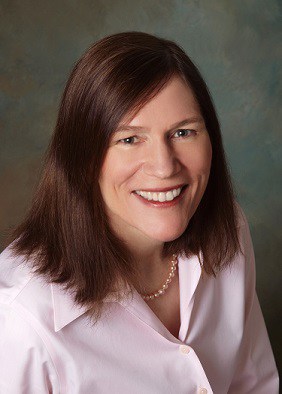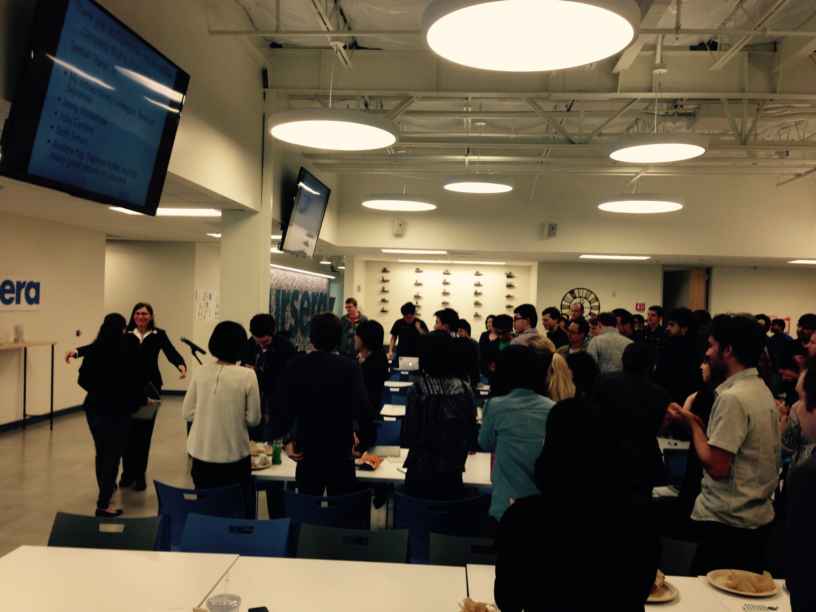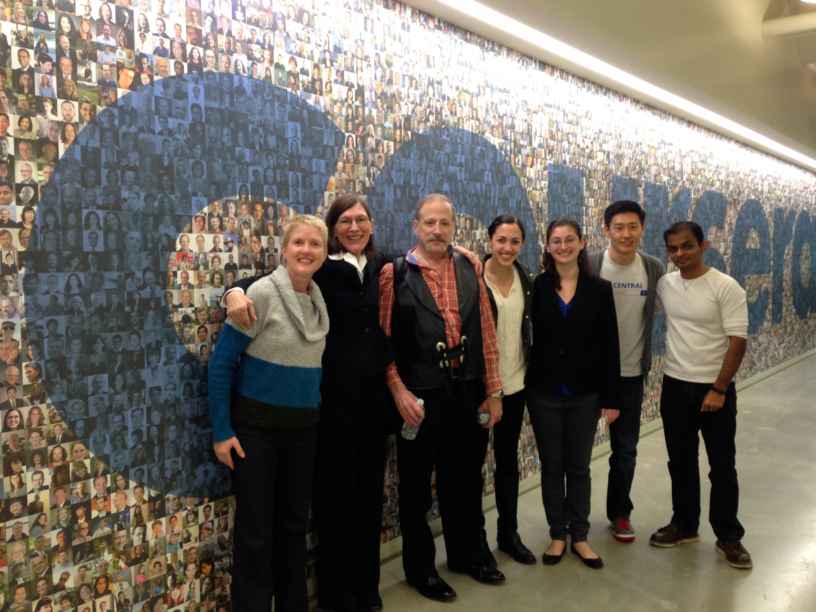Barbara Oakley Talks at Coursera about Learning How to Learn
Popular ‘Learning How to Learn’ MOOC Professor Tells the Story and Lessons of her MOOC
Dhawal Shah and I of Class Central went to a talk at Coursera’s headquarters on Wednesday, where Professor Barbara Oakley, lead instructor of the MOOC Learning How to Learn: Powerful mental tools to help you master tough subjects, was invited to give a talk to the company over lunch.
Coursera headquarters, a plain but modern two-story building in Mountain View, California, has a large open cafeteria space, with rows of tables, resembling a school cafeteria. You almost expect to see plastic lunch trays and small chocolate milk cartons with straws sticking out. But there’s a touch of modernity: cool decorations in the background and two high mounted tv screens to project from a computer with microphones in the front for speakers. On the opposite side is an open kitchen area where there were catered sandwiches for people to pick up before they sat down. In total, there were perhaps 60-70 people, about half of the company (even though on Wednesdays many Courserians work from home). The overall vibe of the Courserians gathered was that of youthfulness, energy, and positivity. They were chatting earnestly, some showing their laptops to others, discussing some code they were working on or reviewing an email. It was imbued with a general feeling of optimism for the future.
Barbara went up to the mic and as soon as she spoke, you could tell that she was genuine.
Barbara was given a glowing introduction by Jenny Wolochow, her main instructor contact at Coursera, with whom she had forged a strong partnership. Barbara went up to the mic and as soon as she spoke, you could tell that she was genuine. She didn’t sound like a polished Ted-talker, her words were heartfelt. She started by saying that she really thought that Coursera was an amazing company, and doing wonderful things for the world. She then proceeded, over the next 45 minutes to talk about her own learning journey, how she came to teach the MOOC, stories from some of the learners, and her reflections on what contributed to the MOOCs success.
The Unique Success of the LHTL MOOC

Learning How to Learn (LHTL) is a four-week MOOC that focuses on how people can best learn, drawing on a wide basis of cognitive psychology and neuroscience. It is widely applicable across almost any subject matter. Its first session drew over 190,000 sign-ups. It also sustained a very high engagement rate throughout the duration of the MOOC, something quite atypical for most MOOCs. It had very high student ratings, with many incredibly enthusiastic comments. By all measures, it was a smashing success. And unique. It’s pretty likely that this was the largest ever “class” on the topic of learning ever held in human history!
Barbara showed several examples of participants writing to her about the MOOC, from 5th graders to esteemed cardiologists. An individual with a masters degree had a telling indictment: in her 18+ years of school, no teacher had ever talked about the process of learning itself. And then there was the story of Barbara’s eldest daughter, a med school student, who makes a cameo appearance in a video, and was called out in a class by her distinguished cardiology professor with a cry of “Hey, you’re the girl in the MOOC video!” The MOOC had global impact, there were even refugees in crisis regions taking the course (many signed up via the work of Dr. Barbara Moser-Mercer, Director of the nonprofit InZone).
Barbara attributes her success with the MOOC to various factors at different levels:
a. Scope – this was a topic that happened to be applicable to nearly everyone, and is an area surprisingly under-addressed
b. Simplicity – the goal was to explain how adults learn in a practical way that “regular” people could understand while avoiding the extraneous information (such as “this is how babies learn…”) that often creeps into full semester university classes
c. Clarity – laying out the design of the course page so that the sequence of activities and what is required of the learner is very clear
d. Promotion – actively working to get the word out. Barbara is a popular press author—this meant that the publisher’s publicist could help get Barbara visibility by working with her to help place strategically-positioned op eds and mass market interviews (she also mentioned Class Central’s listing and humble preview article).
Never mind creating a great MOOC, Barbara’s path to creating any MOOC at all in the first place wasn’t an obvious one, and was filled with hurdles…
The LHTL MOOC Origin Story
While on a panel at an academic conference, she hit it off with the moderator, Terry Sejnowski.
Barbara briefly told the story of how she came to teach the LHTL. While on a panel at an academic conference, she hit it off with the moderator, Terry Sejnowski, who happened to be a renowned neuroscientist, and the Francis Crick professor at the Salk Institute (there’s a good chance you’re renowned if you hold a professorship in the name of a co-discoverer of DNA). Almost right away Terry offered to write the forward to Barbara’s upcoming book, A Mind for Numbers (the source of many concepts taught in the MOOC). They decided to collaborate together on the MOOC, under the auspices of the University of California, at San Diego, where Terry also held an appointment.
Barbara and her husband Philip, turned the basement of their home into a makeshift recording studio.
But there was a major difference between Barbara’s situation and those of many other MOOC professors. Some universities have instructional support divisions to help produce online courses, with expertise and equipment for audio and video recording and editing, a studio, and instructional designers. Barbara did not have the large amounts of money required to access these facilities at her university. So what to do? Why, she would teach herself, of course! Barbara and her husband Philip (whom she gave several shout outs to during her talk as a “saint” and the “most supportive husband in the world”), turned the basement of their home into a makeshift recording studio and they taught themselves all of the techniques they’d need: video recording, sound recording, editing, animation, and green-screen shooting. It was an extraordinary amount of effort. And here’s the kicker: they only spent $5,000 to set this all up to produce the MOOC!
Even in an under-resourced environment, Barbara had a vision for the quality she wanted to achieve to produce a top-notch learning experience. Most people would have said the project just wasn’t feasible. Or waited until they could obtain a university grant to hire videographers and editors. Or they would have just used a simple camera angle of a face sitting behind a desk. But not Barbara…instead she modeled what she would later teach in the MOOC: that anyone can learn new things if they apply themselves.
Barbara’s Keys to Effective Teaching
Barbara also shared some of her tips on how to teach well, in general, and in a MOOC. These are tips many university professors could learn a lot from:
• Have a perspective outside academia – the way you talk in a setting with academic colleagues is different from a general. If no one working on your MOOC has experience outside of academia, find someone who can give you feedback right from the very beginning of your project
• Use metaphors & analogies – many experts want to convey the nuances of their field, but thereby lose the big picture. Barbara suggests a brief mention of the scientific underpinnings and then quickly moving to an illustrative metaphor or analogy that students can latch on to. This is risky because some people will say that you are “dumbing things down”. But think about the majority of your audience, who will be better able to assimilate the key ideas, even when those ideas are complex and difficult
• Take advantage of video – use the video segments to crystallize the major points covered in readings, and then make the readings optional for those who want to explore them more. This is the benefit of a medium like video. Barbara has a high standard for video, because her philosophy is “every second counts”—no fluff or filler, and make sure every part of your video is focused and valuable
• Invest heavily in designing good quizzes and peer assessments – One of the concepts in LHTL is that good quizzes help you learn by forcing you to actively recall new information. Thus, Barbara spent many hours crafting the quiz questions and answers. “Don’t just go for factoids that are easily testable”, she says. Instead, think about how you can help cement knowledge—sometimes in humorous ways—into the quiz-takers’ brains. Take equal care with the design of peer assessments.
• Leverage your TAs (Teaching Assistants) via a hierarchy – for the scale of a large MOOC, you may be using a group of TAs. Barbara recommends having one lead TA and a few senior TAs that you work most closely with, and those senior TAs can then oversee the rest of the TAs. Over time, the senior TAs can take on the task of recruiting future TAs from among the participants
A Personal Connection
Thus, Barbara covered a lot in her 45-minute talk. She made us laugh (her creative use of video), she made us cry (letters from learners talking about how their lives had changed), we marveled at her creative use of video, we were endeared by her doting shout-outs to her husband, and we were amazed at the level of sheer grit that she showed throughout her journey. She thanked lots of people, and also arranged for her lead and senior TAs to be on Skype to be there for that moment and say hello to everyone–Courserians gave them a rousing round of applause.
The whole audience rose to its feet and gave her a sustained ovation
At the end was the most touching moment of all, it was priceless. As Barbara went through her last slide thanking people, her voice started to waver and she was overcome with emotion, barely able to continue. But amazingly, she kept on, reading out the names in a quivering and weak but steady voice. In those precious moments, every soul in that room was completely riveted and tuned in to her. She ended her talk the way she started it, by thanking all of the people at Coursera for what they were doing. Then the whole audience rose to its feet and gave her a sustained ovation for perhaps 30 or 40 seconds, but it felt like 20 minutes.
Barbara Oakley started her talk at 12:15 on a Wednesday and spoke for less than an hour. But by the end it felt like a Friday afternoon, everyone was on such a high. You could tell it wasn’t just short-term high, but the truly meaningful kind you know will stay with you and keep you inspired for a long time to come.








